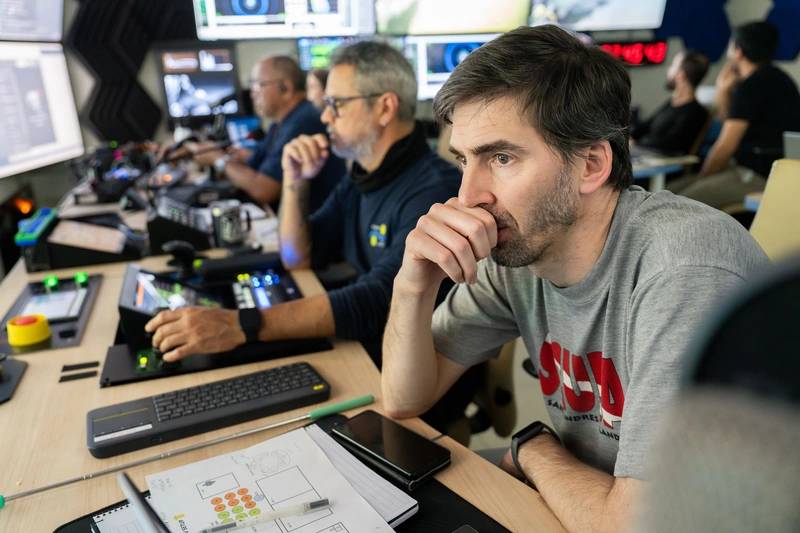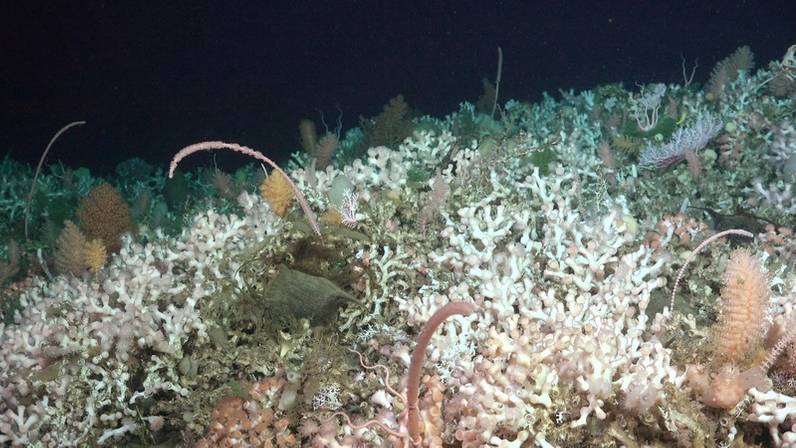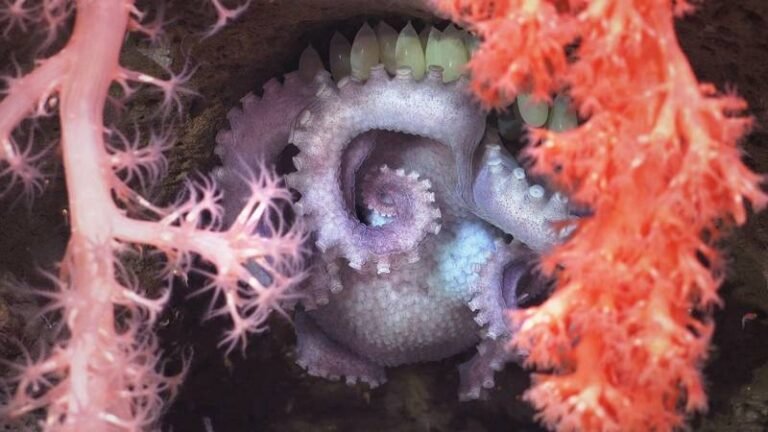First High-Tech Exploration of Argentina’s Mar del Plata Canyon, Schmidt Ocean Institute’s Remotely Operated Vehicle SuBastian shines light on an offshore canyon in Argentine waters nearly twice as deep as the Grand Canyon — capturing images and video of 40 suspected new species, coral fields, and a seastar that resembled a famous cartoon character.
An Argentinian-led expedition on board Schmidt Ocean Institute’s R/V Falkor (too) has captured the attention of millions, inspiring a predominantly Argentine audience with live video feeds from the deep seafloor. Over the past three weeks, nearly 4 million people tuned in to Schmidt Ocean Institute’s divestream, or live video webcast, and watched the expedition unfold from their homes, classrooms, grocery stores, bars, and gyms. They witnessed deep-sea wonders alongside the scientists, including shimmering squids, pink lobsters, and a seastar that resembled the SpongeBob character, Patrick Star.
Many viewers thought this seastar resembled the SpongeBob character, Patrick Star (Patricio Estrella). The encounter was documented in the Mar del Plata Submarine Canyon off Argentina’s coast. The Mar del Plata submarine canyon, one of Argentina’s largest and deepest underwater canyons, is estimated to be deeper than 3500 meters (more than two miles).
Image courtesy ROV SuBastian / Schmidt Ocean Institute
“The deep sea and its awe-inspiring life — from bright corals to mesmerizing octopuses — has captivated an entire nation, thanks to a team of passionate scientists and the millions of people watching their work, via livestream,” said Wendy Schmidt, co-founder and president of Schmidt Ocean Institute. “Argentina is showing the world the power of deep-sea exploration to not only spark wonder, but to remind us how much of our planet remains to be discovered and protected.”
The expedition marks the first time scientists have been able to witness the Mar del Plata Canyon using a remotely operated vehicle (ROV) equipped with sophisticated sampling tools and cameras. The team leading this expedition has studied the area for more than a decade using samples they retrieved with nets and trawls in 2012 and 2013, but this is the first time they have seen their seafloor live.
“This expedition has been a once-in-a-lifetime experience for me, and I’m honored to share it with colleagues I’ve worked with for a decade,” said Chief Scientist Dr. Daniel Lauretta of CONICET and Museo Argentino de Ciencias Naturales Bernardino Rivadavia. “It’s my first time getting to work with an ROV. The image quality captured by ROV SuBastian has been outstanding and helps us better understand the complexity of this habitat and the remarkable biodiversity it supports.”
 Chief Scientist Daniel Lauretta of CONICET (The National Scientific and Technical Research Council), oversees a Remotely Operated Vehicle (ROV) dive from the research vessel Falkor (too) off the coast of Argentina. The expedition took place in the Mar del Plata Canyon, one of Argentina’s largest underwater canyons. The deepest point is over 3,500 meters — nearly twice as deep as the Grand Canyon. The science team documented rich biodiversity, including deep-sea coral reef environments filled with sea anemones, sea cucumbers, sea urchins, snails, and others.
Chief Scientist Daniel Lauretta of CONICET (The National Scientific and Technical Research Council), oversees a Remotely Operated Vehicle (ROV) dive from the research vessel Falkor (too) off the coast of Argentina. The expedition took place in the Mar del Plata Canyon, one of Argentina’s largest underwater canyons. The deepest point is over 3,500 meters — nearly twice as deep as the Grand Canyon. The science team documented rich biodiversity, including deep-sea coral reef environments filled with sea anemones, sea cucumbers, sea urchins, snails, and others.
Image courtesy Misha Vallejo Prut / Schmidt Ocean Institute
The 21-day expedition took place in the Mar del Plata Canyon, one of Argentina’s largest underwater canyons, located 300 kilometers (186 miles) offshore from the city of Mar del Plata in Argentina. The deepest point is over 3,500 meters — almost twice as deep as the Grand Canyon.
The science team documented rich biodiversity, including deep-sea coral reefs at a depth of 1014 meters (deeper than half a mile), comprised of Bathelia candida, a stony, habitat-forming coral species. At 1500 meters depth (nearly a mile), they found a sprawling field of red Anthomastus sp., a deep-sea soft coral known as a mushroom coral. In total, the scientists suspect they have discovered over 40 new species, including sea anemones, sea cucumbers, sea urchins, snails, corals, and crinoids, amongst others. Confirming the new species will take time, as scientists will need to compare these with known animals.
 A large Bathelia candida reef was discovered 1014 meters deep (more than half a mile). The stony, habitat-forming coral species was not expected to be in this area in such quantities. The expedition took place in the Mar del Plata Canyon, off the Coast of Argentina.
A large Bathelia candida reef was discovered 1014 meters deep (more than half a mile). The stony, habitat-forming coral species was not expected to be in this area in such quantities. The expedition took place in the Mar del Plata Canyon, off the Coast of Argentina.
Image courtesy ROV SuBastian / Schmidt Ocean Institute
All Schmidt Ocean Institute ROV dives are live-streamed to YouTube and Twitch, allowing anyone with an internet connection to join the scientists as they explore the deep sea in real time. This expedition shattered engagement records for the Institute. One way to measure engagement is views. Most of the Institute’s dives average around 4,000 views; this expedition averaged 500,000 views per dive, with a total of over 17.5 million views over three weeks. About three-quarters of the audience were Argentinians.
 Brenda Doti (Associate Researcher, CONICET) works with a specimen of a crustacean in the Main Lab of research vessel Falkor (too). The science team documented rich biodiversity, including deep-sea coral reef environments filled with sea anemones, sea cucumbers, sea urchins, snails, and others.
Brenda Doti (Associate Researcher, CONICET) works with a specimen of a crustacean in the Main Lab of research vessel Falkor (too). The science team documented rich biodiversity, including deep-sea coral reef environments filled with sea anemones, sea cucumbers, sea urchins, snails, and others.
Image courtesy Misha Vallejo Prut / Schmidt Ocean Institute
“It’s been incredible to see how people of all ages have connected with the deep sea,” said science team member Dr. Martín Brogger of CONICET and the Instituto de Biología de Organismos Marinos. “We received hundreds of messages from families, teachers, and kids who felt inspired, surprised, and even emotional watching the live broadcasts.
The Impact of Marine Biology on Young Students
During a recent marine expedition in the Mar del Plata submarine canyon in Argentina, young students had the opportunity to witness the wonders of the deep sea. Some of these students shared that they now dream of becoming marine biologists, showing how the experience went beyond science to create a sense of wonder and curiosity that can last a lifetime.
One of the highlights of the expedition was the discovery of a sprawling field of red Anthomastus sp., a deep-sea soft coral known as a mushroom coral, at a depth of 1500 meters. This finding not only added to the scientific knowledge of the area but also captivated the imagination of the students and researchers alike.
Dr. Lauretta, a member of the research team, mentioned how heartwarming it was to see videos of young children pretending to operate ROVs to explore the deep ocean. These moments filled him with joy and hope for the future of marine science.
Aside from inspiring future scientists, the data collected during the expedition will serve as a foundation for future research and resource management. The team also observed evidence of human activity reaching the deep-sea canyon, with debris such as shoes, plastic bags, and fishing gear present in the area.
Dr. Jyotika Virmani, the Executive Director of Schmidt Ocean Institute, emphasized the power of ocean exploration in igniting the imagination. The expedition not only allowed Argentinians to fall in love with their own deep-sea environment but also showcased the importance of sharing scientific research with a wider audience.
Conclusion
The impact of marine biology goes beyond the realm of science; it has the potential to inspire future generations and instill a sense of wonder and curiosity that can last a lifetime. By engaging young students in marine expeditions and research, we are not only shaping the future of marine science but also fostering a deeper connection to the world’s oceans.
As we continue to explore the mysteries of the deep sea, let us remember the importance of inspiring and educating the next generation of marine biologists and ocean enthusiasts.

